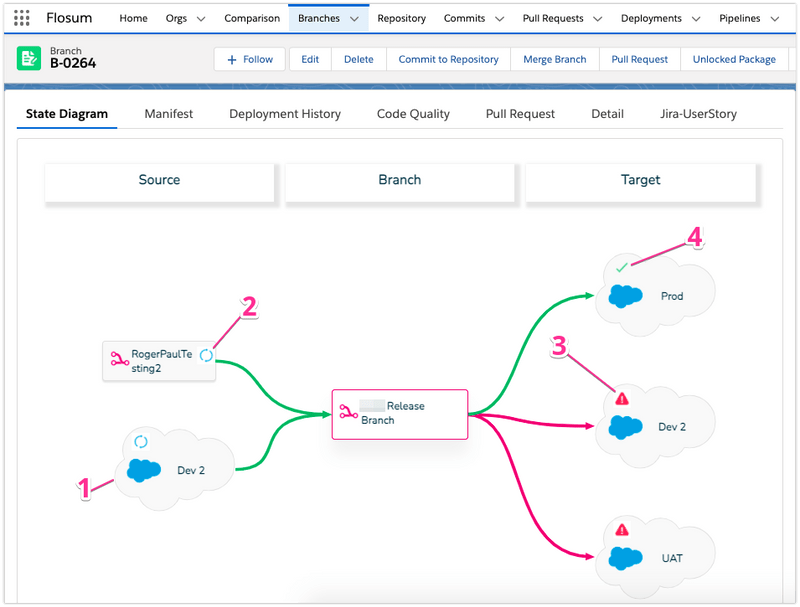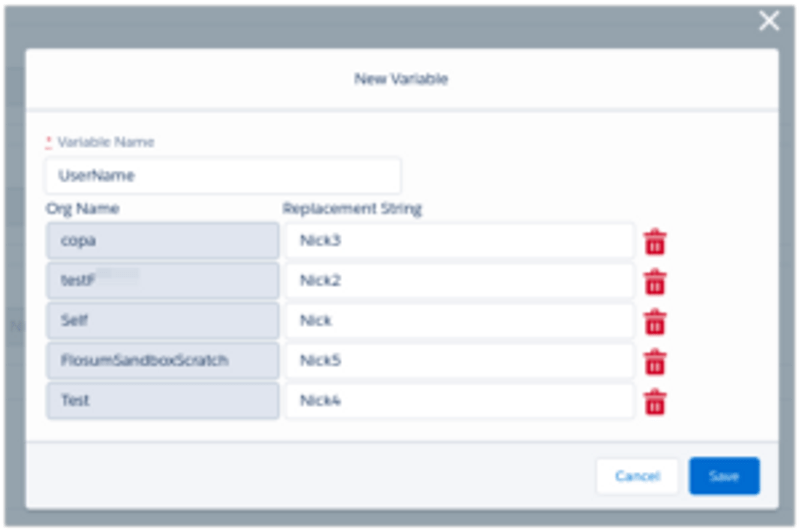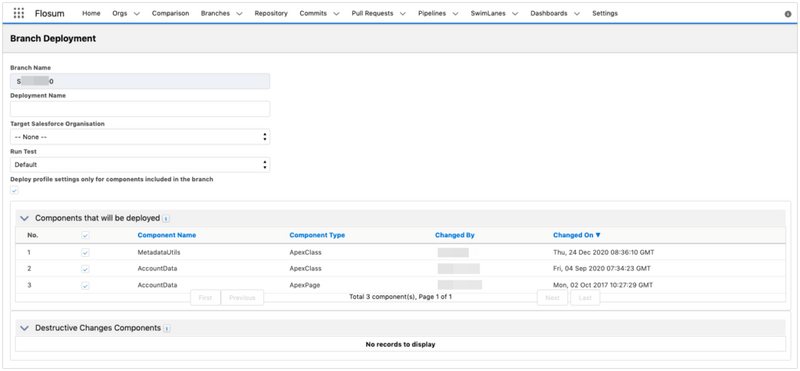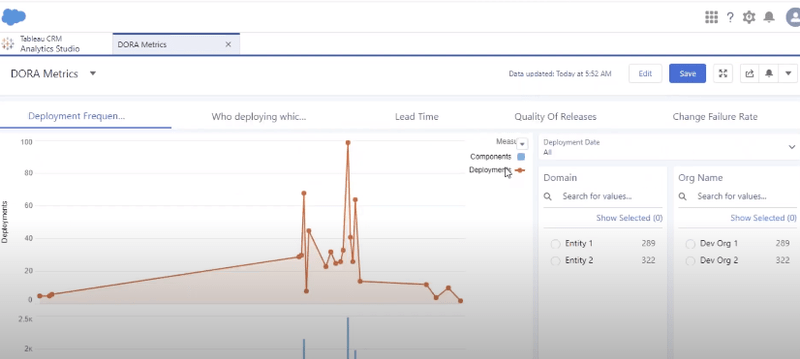You spoke, we listened, and we built it. The Flosum Summer 2021 release brings new and enhanced features to help Salesforce developers and Salesforce DevOps teams skyrocket their productivity
Flosum Summer '21 Release has arrived!
Here at Flosum, we're committed to rapid product innovation and simplify Salesforce DevOps.
The Summer Release is our most significant release to date. It's packed with a plethora of enhancements and newly introduced features for Salesforce release management, Salesforce data migration, and Salesforce data backup and archival.
As a team, we spent a lot of time with our clients, Salesforce partners, and teams of Salesforce developers inside and outside of the company listening and learning. We've been tinkering away at new features to help your Salesforce DevOps team skyrocket the developer's velocity like never before.
Get started with Flosum Summer '21 Release
1.Watch our Flosum experts walk you through the key release feature where they highlights what is store for admins, developers, or both across the Flosum Release Management Solution, Database Backup & Recovery tool and Data Migrator.
2. Check out the Flosum community portal for Flosum Summer 2021 Release Notes.
You can find a high-level description of each of the feature enhancements and new features introduced in the Summer '21 Release in our Flosum Community Portal. It is also an excellent resource to browse our collection of articles, release notes and webinars designed to help you get the most out of Flosum.
Flosum Summer '21 Release Highlights for Salesforce Developers
The Flosum ‘21 Summer release aims to help your Salesforce DevOps team collaborate securely, deliver solutions more quickly, and continuously improve their end-user satisfaction and value. Here are exciting new features we’ve launched to improve your DevOps efficiency:
Branch State Diagram
The summer release introduces the visual state diagram as the default tab to instantly provide visibility into the state of the branch and the status of the workflow. The status of each operation is marked with distinct symbols and color-coded lines. It also tracks whether the latest operation happened with the latest version of the branch or not and if it is out of sync.

Why we love it?
It instantly gives you a complete overview of the branch. A nice visual of all the activities, the sources of components that are sitting in your branch, and helps you track progress and errors at each stage in that branch. The lines are color-coded to signify the last operation that occurred with the target entity all the way through. If the operation has succeeded, you see a green line and if it has failed, it will show a red line.
Improved UI at the Branch Level
The Flosum Summer '21 Release introduces a new intuitive UI at the branch level. We have reorganized the order of the tab buttons at the Branch level to make it easy to navigate and accelerate the developer flow. The most important buttons are now much easier to locate while the less used ones can be accessed through the drop downs menu within buttons.
Why we love it?
It cuts out the clutter and optimizes user flow to make it easier for you to navigate. It is the first phase of a better UI where you can now validate, deploy, run the pipeline, and enjoy all the new features introduced at the Branch level. The improved intuitive arrangement strikes a balanced approach between a simple design and a more intuitive arrangement for a better user experience.
Environment variables
Flosum is introducing the innovative concept of 'Environment Variables' that allows you to define any environment variable in the XML of that component. You can edit and create a tag, and define the value of the tag for every org that you would deploy that component to. As part of the deployment flow, Flosum will replace the tag for the value for that particular environment.

Why we love it?
A lot of our clients have asked for this innovative feature. The new Environment Variables feature will be significantly useful in reducing the number of post-deployment steps that you might be completing with your deployments. We reviewed the post-deployment steps that were shared with us that were being done manually. Flosum decided to automate these and help clients change the components on the fly.
Partial Branch Deployments
Now you can do partial deployments from your branch. Before the Summer '21 release, branches were deployed as a whole. So earlier, if you ever wanted to deploy only a part of the components and the branch, you would have to create a new branch, merge the existing branch into that and then deploy that branch.
Now you can simply click the Deploy or Validate tab under the Branches tab, select the components that you want to deploy, and voila! You are good to go. Flosum also fulfills a long-standing request to introduce the same facility for 'Destructive Changes' as well. You can now cherry-pick the components you want to make as part of your package your components

Why we love it?
It makes life a lot easier! It allows you to select your components, whether for Deployment or Destructive Changes. You can now simply cherry-pick the components that you are interested in deploying and deploy the subset of components. We are also happy to announce you can now give memorable names to your deployments and metadata orgs instead of using an autogenerated random name.
Because you can now work on the subset of the components of the metadata org, you can understand the exact components in which the operation occurred. You’ll no longer need to go into the Notes & Attachments Folder to view them - you can get the status or whether the deployed component was successful or contains errors right in the branch dashboard itself.
Branch Permissions
Yes! We heard you and are finally introducing the ability to assign a custom set of branch permissions to a group of users. You can now go to the 'Permissions' tab in your branches to select and assign permissions to users for a particular branch. Presently, it is available at the group level. You will need to categorize your users into different groups and assign the necessary permissions from there.
Why we love it?
It makes life so much easier for Salesforce developers and admins. It works similarly to the Org permissions where you assign permissions to orgs. You can choose from permission sets as well as create your own permission sets. It also allows you to group your users in any way that you would like to assign them the necessary permissions.
Exciting New Changes: Deployment Analyzer: Phase 2
Flosum introduces a plethora of new features and enhancements in the latest iteration of Flosum's Deployment Analyzer to improve developer workflow. Already considered a powerful tool that helps catch a lot of errors upfront in a single shot, the deployment analyzer now comes with retrieval capability. To get started, you can select the org from which you would like to retrieve. Next, filter the screen by the type of component that is missing or handpick the components you would like to retrieve and add them directly into the branch.
Why we love it?
Now you can retrieve missing dependent metadata components by clicking on the “Get Components” button, and add those components to the branch. It eliminates the need to do a snapshot and push it to the branch.
DORA Matrix
Many of you have asked for DevOps Research and Assessment (DORA) metrics so that you can focus on improving your DevOps maturity. Today, we are excited to inform you that we have built them into Flosum for you so you'll be able to measure and optimize your Salesforce DevOps practices.

Why we love it?
The Four key DORA metrics specifically measure Deployment Frequency, Lead Time for Changes, Change Failure Rate, and Time to Restore Service to help measure developer velocity and quality. You can visualize these four key DORA metrics in the DORA metrics dashboard for a deeper and comparative categorization of your performance. It enables your Salesforce DevOps team to get instant feedback on their performance so they can take corrective measures if necessary.
Scheduled and On-Demand Apex PMD
As of now, the Apex PMD code scan integration runs every time you add metadata components to the branch. If you have code quality scanning available, it will automatically complete the code scan for you. However, you might prefer to schedule it, and that is what we have introduced in the Flosum Summer '21 Release.
You now can execute Apex PMD on a scheduled basis (weekly or daily) as well as on-demand based on your preference. Please note that this feature will only run if you have enabled the Flag "Enable for Scheduled Apex PMD" on the Details tab of the branch.
Why we love it?
Usually, when you run Apex PMD automatically at the time of adding components to a branch, it only runs run on the components being added. It does not run on all the components of the branch. When you run it on schedule or on-demand, it will run on all the components in the branch and effectively give you the latest results of that particular branch.
As a PM or an Architect, this offers you significant insights and enables you to see at that time, the status of your branch on a daily basis and if your issues are being reduced or not. Ultimately, this significantly helps in enhancing code quality.
Data Masking
Introduced recently in our Flosum Spring '21 Release, Data Masking has received wide popularity. Based on feedback from you all, Flosum now provides a higher level of logging, refreshing every 30 seconds.
Yet another feature that we've added to data masking is the ability to add filters. You can now also append any suffix value to an email address in the data masking column as well as add an additional email address if needed.
Why we love it?
The higher level of logging with a refresh rate of every 30 seconds allows you to track what stage your data masking operations are at.
Flosum Vlocity: Additional Vlocity Support
The new Flosum Vlocity feature supports the following commands:
- Schedule Deployment from Branch
- Pipeline Deployment
- Packretry
- Test other servers
- Install Vlocity Initial
- Clean Vlocity Data
- Separate Matrix Versions
- Separate Integration Procedures
Metadata API version 52 changes
With the latest Salesforce Summer '21 release, we are supporting all the metadata components that are supported in API version 52.0. Please check this updated list for all the metadata components that are supported by Flosum.
Data Migrator Features
Here are the new functionalities added to the Data Migrator component:
1) Connect Your Organizations – register and connect your organizations one time to reuse easily
2) Migration of Product and Price Rules with Custom Conditions
3) Upsert Options.
Data Backup and Recovery Features
Flosum's newest service is used for backing up your Salesforce data. It is currently hosted on Amazon Web services (AWS) and will eventually be hosted on Azure and Google Cloud. Here's an overview of just a few features we've implemented in our Database Backup & Recovery tool:
- added support for Knowledge Object
- added support for Contract Object
- added support for PricebookEntry
- added support for Big Object
- added support for Record Types
- added Restore Backup feature
- added functionality for control API Request Limit Salesforce
- added diagrams
- added Selective Record Restore mode
- added Removed Restore mode
- added support Person Account
- added logic for mapping exist record in org.
Branch to Branch Compare in Pull Request
Flosum now introduces the ability to select any branch and compare your items against another branch. By default, it still compares against the repository that is associated with the branch, however you can now also compare one branch to another at Review in Pull Request
Why we love it?
Pull Request is Flosum's code review mechanism. As a reviewer, you can see all the components in your branch and whether a version of them exists in the repository. By matching the repository with production, it gives you the ability to see changes in the branch compared to what sits in production.
And much more!
We've only shown you a few highlights of our work in progress here at Flosum and we welcome your thoughts on the direction we're taking with Flosum.
Stay tuned for exciting monthly training sessions on how Flosum can help and bi-monthly Leadership discussions to drive DevOps/ Business needs ahead.





